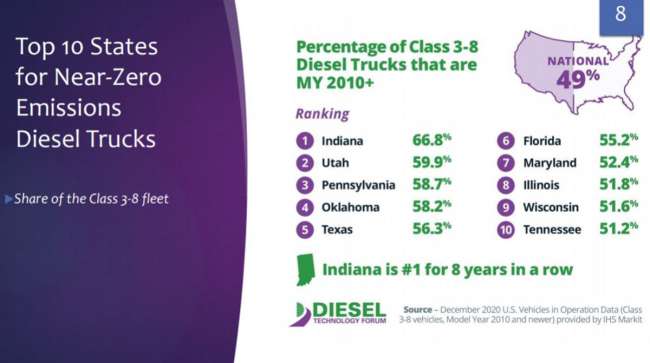Senior Reporter
Commercial Classes 3-8 Trucks Cutting GHG Emissions

[Stay on top of transportation news: Get TTNews in your inbox.]
Zero-emission electric commercial vehicles appear likely to become routine in the years ahead, but now 49% of all Classes 3-8 commercial vehicles, or nearly 5.5 million trucks, already are using advanced diesel engine technology to reduce greenhouse gas emissions, according to a new study.
“This advanced generation of diesel is a bridge technology that is delivering carbon dioxide reductions that are very important now,” Diesel Technology Forum Executive Director Allen Schaeffer said during a recent online presentation.
A few days later, scientists reported the all-time high CO2 level in May, as recorded in Hawaii — an average of 419 parts per million compared with the previous record of 417 parts per million a year earlier.

Schaeffer
AutoForecast Solutions, in research the Diesel Technology Forum commissioned, found that since 2007 the newest-generation diesel trucks on U.S. roads eliminated 202 million tonnes of CO2, 27 million tonnes of nitrogen oxides and 1.6 million tonnes of particulate matter. They also saved almost 20 billion gallons of diesel and 296 million barrels of crude oil.
The study predicted the growing number of more efficient diesel trucks on the road will eliminate 1.3 billion tonnes of carbon dioxide between 2020 and 2030.
Also, the study found that the number of advanced technology diesel commercial trucks in the U.S. grew by 6% between July 2019 and December 2020. Florida, Hawaii and Pennsylvania experienced the largest growth in their clean diesel fleets during that period.
Twenty-three states are seeing growth of their clean diesel fleets occur faster than the national average of 6.3%, Schaeffer said.
Clean diesel technology use by Classes 3-8 commercial trucks by Transport Topics on Scribd
According to data from IHS Markit covering 2019-2020 vehicles in operation, 15 states’ commercial diesel truck Classes 3-8 populations are now at or above the 49% national average. Indiana is the highest-ranking state for adoption of new-technology diesel commercial trucks at 67%, followed by Utah (60%) and Pennsylvania (59%).
When it comes to his state, Indiana Motor Truck Association President Gary Langston said, “At least part of the answer is the fact that we have nearly all of the nation’s major trucking fleets registered here in the state. Carriers from around the country register in Indiana because our Department of Revenue is very efficient and very customer-focused.”

Langston
He added, “As you know, the big companies typically replace their equipment more often, which results in running newer equipment. I
would think the small carriers would likely be a higher percentage of older equipment in that they run their equipment longer.”
Schaeffer said the evolution of clean diesel engines from 2007 onward involves “sustained progress” toward a cleaner environment. Additional stringent controls on diesel engine emissions of NOx are on tap, coming first in California through state regulations and then expected nationally with the Environmental Protection Agency’s Cleaner Trucks Initiative.
Schaeffer said diesel engine technology is keeping up through a “very high level of understanding of combustion.” That includes cylinder design and advanced coatings that help control temperature aimed at balancing emissions and efficiency.

When the pandemic started, drivers faced crowded parking lots, closed rest areas and minimal roadside support. And almost a year and a half later they still face the fear of not finding a place to park, which means having no place to rest. In this episode, host Michael Freeze seeks answers from those on the forefront of research and legislative action. Hear a snippet above, and get the full program by going to RoadSigns.TTNews.com.
At the same time, he said emission-control systems are “becoming more compact and efficient and a little lower in cost.”
“Ultra-low-sulfur diesel is the foundation of all this,” he said.
Schaeffer noted that there is growing interest and investment in renewable fuel refineries from conventional petroleum refiners.
“Phillips 66 and Marathon are evolving to provide some greater supply of renewable diesel fuel for tomorrow,” he said.
Renewable diesel, or green diesel, is a biofuel that is chemically the same as petroleum diesel fuel and can substitute for it. The U.S. Energy Information Administration said it can be produced from cellulosic biomass materials such as crop residues, wood and sawdust, and switchgrass. It also qualifies as an advanced biofuel under the Renewable Fuel Standard Program.
Finnish company Neste, the world’s leading producer of renewable diesel and largest renewable diesel supplier into California, in May announced it opened two renewable diesel fueling stations in Southern California. The company’s ambition is to create a renewable-diesel fueling network across the U.S. West Coast.
To date, Neste has provided more than 1.5 billion gallons of renewable diesel to California businesses and cities, delivering the same climate benefits as building about 2,500 wind turbines or planting 202 million trees, according to the company.
“If used across the entire fleet, not just new vehicles,” Schaeffer said, “you can completely alter the carbon footprint of your operation as you go through a tank of renewable diesel fuel.”
Want more news? Listen to today's daily briefing below or go here for more info:

